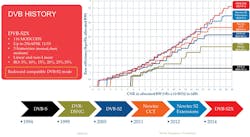What’s the Difference Between DVB-S2 and DVB-S2X Standards?
In 1994, the world's first digital satellite TV services were launched in Thailand and South Africa. They utilized the newly developed Digital Video Broadcasting Satellite (DVB-S) system.
Over time, DVB-S became the most popular system for delivering digital TV broadcasts. Technology has advanced and spread tremendously since then, which led to an increased need for advances to the DVB-S system. Thus, the DVB-S2 and DVB-S2X systems were born!
Let's take a look at both DVB-S2 and DVB-S2X and the main differences that exist between them.
DVB-S2
One of the biggest reasons for the second generation of digital video broadcasting was to enable the commercial launch of HDTV services. More specifically, some major benefits of DVB-S2 compared to DVB-S include:
- Low-density parity check (LDPC) forward error correction (FEC)
- Variable code modulation (VCM)
- Adaptive code modulation (ACM)
- Enhanced modulation schemes up to 32 APSK
- Support for MPEG-2 TS-based systems and MPEG-4 audio-video streams
DVB-S2 is able to achieve about a 30% increase in spectral performance compared to the original DVB-S. This allows for an increase in bit rate over the same DVB-S frequency bandwidth. In fact, it comes close to the Shannon Limit, the theoretical maximum information transfer rate in a channel for a given noise level.
DVB-S2 increases TV satellite spectral performance by about 30%!
DVB-S2 was formally published as an ETSI standard in 2005. Since then, a number of major satellite broadcasters in both the U.S. and Europe have adopted the service.
DVB-S2 is still evolving with our constantly changing technology. In 2012, the DVB Project approved a new version of the specification that adds the reception of wideband signals (for example, 200 MHz or 500 MHz). Upgrades and enhancements continue to be made to the service.
For related information, check out Breaking Down the RF Spectrum - Which Bandwidth is Best for Your Application?
DVB-S2X
The DVB-S2X system is not necessarily another model made up of the DVB-S2, but rather an extension. DVB-S2X was specified in the mid-2000s and provides additional technologies and features for the core applications of DVB-S2. Applications include Direct to Home (DTH), Contribution, VSAT, and DSNG. It also covers an extended operating range with a focus on delivery to emerging markets, such as cellular devices and 5G.
Cellular towers equipped with DVB-S2 capabilities will make for easy adaption of 5G networks.
DVB-S2X supports very low C/N (down to −10 dB) for mobile applications like marine, aerospace, trains, etc. Like DVB-S2, DVB-S2X uses LDPC FEC schemes and BCH FEC as an outer code.
DVB-S2X incorporates additional features and technologies, such as:
- More granularity of modulation and coding modes
- Smaller filter roll-off options of 5%, 10%, 20%, and 35%
- New constellation options for linear and nonlinear channels
- Channel bonding up to three channels
- More scrambling options for critical co-channel interference situations
- Very low SNR operation supporting C/N down to −10 dB
- Super Frame option
Shown is a comparison of DVB model performance.
Technology upgrades and improvements also enable DVB-S2X to use smaller antennas and future broadband interactive networks for VSAT applications (intra-system interference mitigation, beam-hopping, and multi-format transmissions).




